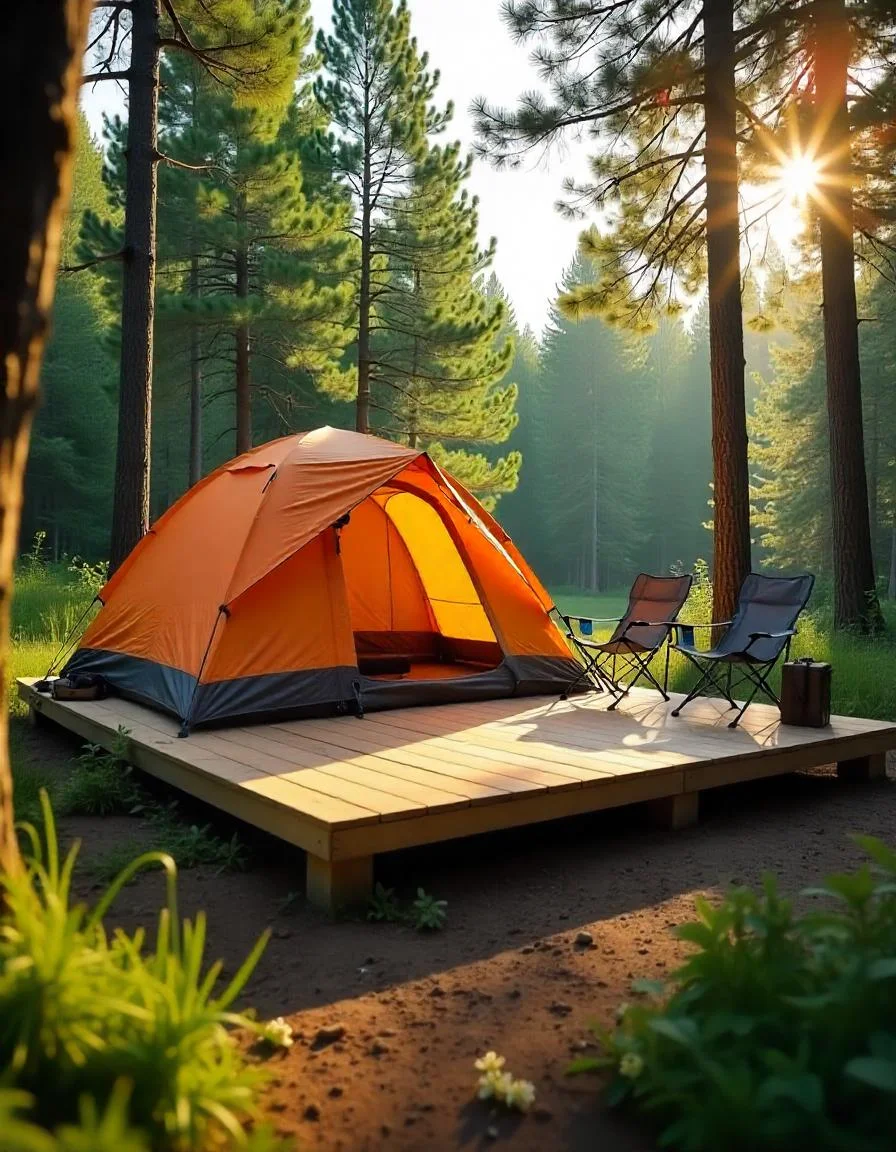Outdoor adventures, whether you’re camping, attending a festival, or enjoying a day at the beach, often come with the challenge of finding a comfortable, stable surface to sit, sleep, or set up your equipment. Travel decking provides an ideal solution to this problem. These portable, easy-to-set-up platforms offer a flat, sturdy surface, protecting you from the elements and uneven ground.
In this guide, we’ll explore the various types of travel decking, its benefits, how to choose the right system, and much more to help you make the most of your outdoor experience.
What Is Travel Decking?
Travel decking refers to portable decking systems designed for use in outdoor environments. These modular and lightweight platforms create a solid, level surface that can be easily transported and assembled. Whether you’re camping, attending an outdoor event, or just enjoying the outdoors, these decks offer comfort and convenience, elevating your outdoor experience.
Made from various materials like composite, plastic, and wood, travel decking is perfect for those who want an easy-to-use, durable platform for outdoor activities. Whether you’re facing wet, uneven terrain or simply want a clean and dry space, travel decking is the solution you need.
Types of Travel Decking Materials
When choosing a travel decking system, the material is a crucial factor. Here are the most common types of materials used in travel decking systems:
1. Composite Decking
Composite decking is one of the most popular options for outdoor use. It is made from a combination of wood fibers and plastic, offering a highly durable, weather-resistant surface. Composite decking is lightweight, resistant to rot, and requires minimal maintenance. Its non-slip surface makes it an ideal choice for wet or damp conditions. Composite decking systems are also UV resistant, ensuring that they won’t fade or degrade when exposed to sunlight.
2. Wooden Decking
For a more natural look, wooden travel decking is a great choice. Wooden decking is typically made from treated lumber, which offers a sturdy and eco-friendly option. While wooden decking can withstand the elements, it does require more maintenance than composite or plastic options. Regular treatment and sealing are necessary to prevent rot, mold, and insect damage. Wooden decking is perfect for those who value aesthetics and are willing to invest time in upkeep.
3. Plastic Decking
Plastic decking is lightweight and easy to clean, making it ideal for short-term or frequent use. Made from high-density polyethylene (HDPE), plastic decking is resistant to UV damage, cracking, and fading. Its surface is also non-porous, so it doesn’t absorb moisture, preventing mold and mildew growth. Plastic decking is typically the most affordable option and works well in outdoor settings where portability and easy maintenance are essential.
4. Modular Decking Systems
One of the main advantages of travel decking is its modularity. Modular decking systems consist of interlocking tiles or snap-together pieces that can be assembled to create a custom-sized deck. This flexibility allows users to adjust the size of their decking according to their specific needs. Whether you’re setting up a small platform for your tent or creating a larger space for an outdoor event, modular decking makes it easy to create a flat, stable surface.
Benefits of Travel Decking
Using travel decking in outdoor environments offers several key benefits:
1. Portability and Convenience
One of the biggest advantages of portable decking systems is their portability. These systems are lightweight, easy to transport, and can be packed into compact sizes. Many systems come with carrying cases or can be easily rolled up for storage, making them perfect for those who frequently travel or move between different outdoor locations.
2. Comfort and Stability
When you’re outdoors, an uneven surface can make sitting, sleeping, or standing uncomfortable. Travel decking provides a level and stable surface, preventing discomfort caused by rocky, muddy, or sloped ground. Whether you’re setting up a tent, lounging in a chair, or enjoying a meal, decking ensures that your outdoor space is comfortable.
3. Protection from the Elements
By elevating you above the ground, travel decking offers protection from water, dirt, and harsh weather conditions. When it’s rainy or damp, a portable deck prevents you from sitting directly on the wet ground, keeping you dry and comfortable. Additionally, decking can protect your gear, preventing it from getting wet or damaged.
4. Durability and Long-Lasting Use
Travel decking systems are designed to be durable and long-lasting. Composite and plastic decking, in particular, are resistant to wear and tear, UV damage, and rot. This makes them perfect for long-term use, ensuring that your decking system will withstand many outdoor adventures without needing frequent repairs or replacements.
5. Easy Maintenance
Unlike other outdoor solutions, such as tarps or blankets, decking systems are incredibly easy to maintain. Most decking systems, especially those made from composite or plastic materials, can be cleaned with just soap and water. Wooden decking requires more upkeep, but with regular treatment, it can last for many years.
Uses of Travel Decking
Travel decking systems are versatile and can be used for a variety of outdoor activities. Here are some of the most popular uses:
1. Camping
One of the most common uses of travel decking is for camping. Whether you’re camping in a national park, a remote wilderness area, or a busy campground, having a stable, level surface to set up your tent is essential. Travel decking allows you to create a flat surface, preventing discomfort from rocks, roots, or uneven ground.
2. Outdoor Events and Festivals
Travel decking is also ideal for outdoor festivals, concerts, and other events. When attending an event in a grassy or muddy field, decking can create a clean, dry space for seating, dining, or dancing. Modular decking systems are especially useful in these situations because they can be easily expanded or adjusted depending on the size of the crowd.
3. Beach Trips and Picnics
Travel decking systems can also be used for beach trips or picnics. When the sand is damp or uneven, having a stable surface to sit or eat on can make a big difference. Portable decking elevates your setup, keeping you dry and comfortable while enjoying the outdoors.
4. Backyard Decks
For temporary backyard setups, travel decking is an excellent option. Whether hosting a backyard barbecue or setting up for a family gathering, portable decking provides a stable surface for seating, dining, or entertainment. It’s easy to set up and take down, making it a convenient solution for short-term outdoor use.
How to Choose the Right Travel Decking System
When choosing a travel decking system, there are several factors to consider:
1. Weight and Portability
Choose a decking system that is lightweight and easy to transport. If you plan on using the decking frequently, consider a system that packs into a compact size for easy storage and travel.
2. Material and Durability
Select the material based on your needs and the conditions you’ll face. Composite and plastic are great for wet conditions and require minimal maintenance, while wooden decking offers a more natural aesthetic but requires more upkeep.
3. Size and Flexibility
Modular systems are ideal if you need flexibility in size and shape. Look for a system that can be easily assembled and disassembled to suit your specific needs.
4. Price and Value
While high-quality decking systems may have a higher upfront cost, they offer better durability and long-term value. Consider the overall cost and compare different systems to find the best option for your budget.
Environmental Impact of Travel Decking
As with any outdoor product, it’s important to consider the environmental impact of travel decking. Many decking systems are made from eco-friendly materials, such as recycled plastic or sustainable wood, making them a greener option compared to other outdoor solutions. However, it’s important to check the materials and production processes to ensure you’re making an environmentally responsible choice.
Cost and Budget Considerations
The price of travel decking systems can vary based on the material, size, and brand. Composite and plastic decking typically cost more than wooden options but require less maintenance. Wooden decking is often more affordable but may require periodic treatment to prevent damage. Consider your budget and how often you plan to use the decking when making your decision.
Maintenance and Durability
To ensure your travel decking lasts for years, regular maintenance is essential. Composite and plastic systems usually only require occasional cleaning with soap and water, while wooden systems should be treated and sealed periodically to protect against weather damage and rot.
Comparison with Other Outdoor Solutions
While travel decking is a great option for outdoor activities, there are other alternatives worth considering, such as tarps, inflatable platforms, and camping mats. However, these options often don’t provide the same level of stability, comfort, or durability as decking systems. Decking offers a more elevated and long-lasting solution for outdoor spaces.
Conclusion
Travel decking systems offer a versatile and practical solution for outdoor enthusiasts. Whether you’re camping, attending an event, or simply relaxing outdoors, portable decking ensures you have a level, comfortable surface to enjoy. With a range of materials and designs available, you can find the perfect system for your needs, ensuring a better, more enjoyable outdoor experience.


